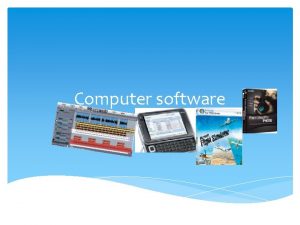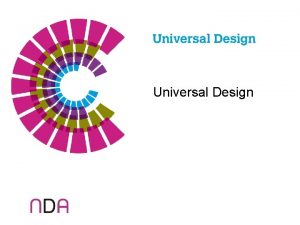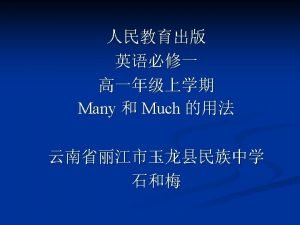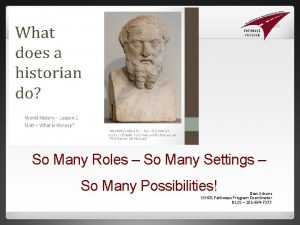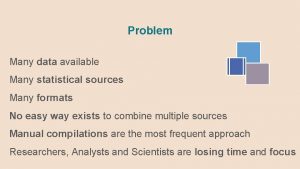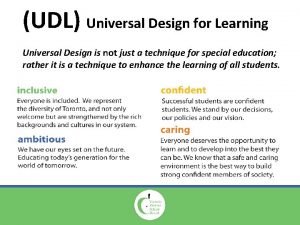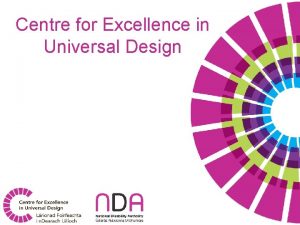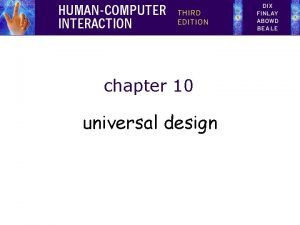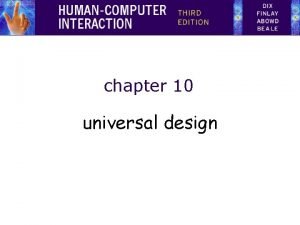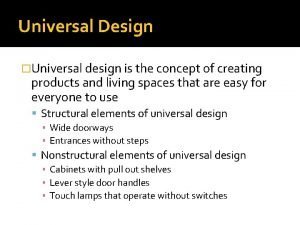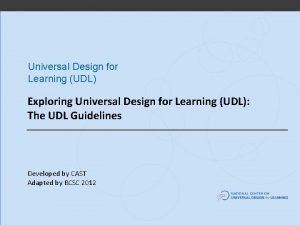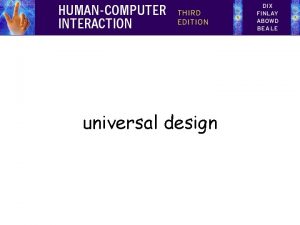Universal Design Universal design caters for many users



































- Slides: 35

Universal Design Universal design caters for many users, irrelevant of gender, age, size, strength, mobility, hearing, vision etc. Good design enables, bad design disables.

Scenario 1 • You have been hired by a company to design a kid’s toy, one that could be included in a happy meal • What do you need to know in order to complete this task? • What factors must you consider in your design?

Scenario 2 • In 1926, the Army designed the first airplane cockpit. It was designed around the average physical dimensions (10) of male pilots in the 1920 s • With the expansion of the Air Force in 1947, performance declined and deaths increased? • Why do you think this happened? Circular, steering-wheel type yoke in a Lisunov Li-2 (1940 s), image by Varga. A (GFDL)

“The only thing important about design is how it relates to people. ” Victor Papanek, 1968

Universal Design • • • Inclusive Design for All User Needs Design User-Centered Design Human-Centered Design Barrier-Free Design Accessible Design Adaptable Design Transgenerational design Design for a Broader Average

What is Universal Design? • Design and composition of an environment so that it can be accessed, understood and used to the greatest extent possible by all people regardless of their age, size or disability • Approach to design that honors human diversity. It addresses the right for everyone to use all spaces, products and information, in an independent, inclusive and equal way • Invites engineers to go beyond compliance with access codes, to create excellent, people-centered design

Why Universal Design? • Individual benefits • Social benefits – – Aging population Home healthcare Independent living Participation in society • Business benefits – Increased market reach – Enhanced customer satisfaction and retention – Market crossover – Increased customer expectations • Compliance with legislation and standards Better products for everyone!

Why We Need Universal Design

The Principles of Universal Design 1. 2. 3. 4. 5. 6. 7. Equitable Use Flexibility in Use Simple and Intuitive Perceptible Information Tolerance for Error Low Physical Effort Size and Space for Approach and Use

The design is useful and marketable to any group of users Principle 1: Equitable Use 1. Provide the same means of use for all users: identical whenever possible; equivalent when not 2. Avoid segregating or stigmatising any users 3. Provisions for privacy, security and safety should be equally available to all users 4. Make the design appealing to all users

Can everyone use the same entrance? Principle 1: Equitable Use

Does the design provide the same means of use for all? Principle 1: Equitable Use

The design accommodates a range of individual preferences and abilities. Principle 2: Flexibility in Use 1. 2. 3. 4. Provide choice in method of use Accommodate right-handed or left-handed access and use Facilitate the user’s accuracy and precision Provide adaptability to the user’s pace

Does the park seating accommodate individual preference? Principle 2: Flexibility in Use

Can the design be used by left and right handed people? Principle 2: Flexibility in Use

Does the design work well for children, adults and older people? Principle 2: Flexibility in Use

Use of the design is easy to understand regardless of the user’s experience, knowledge, language skills, or current concentration level. Principle 3: Simple and Intuitive 1. 2. 3. 4. 5. Eliminate unnecessary complexity Be consistent with user expectations and intuition Accommodate a wide range of literacy and language skills Arrange information consistent with its importance Provide effective prompting and feedback during and after task completion

Is it easy to understand? Can you make it work? Principle 3: Simple and Intuitive

Is it easy to understand? Can you make it work? Principle 3: Simple and Intuitive

The design communicates necessary information effectively to the user, regardless of ambient conditions or the user’s sensory abilities. Principle 4: Perceptible Information 1. 2. 3. 4. 5. Use different modes (pictorial, verbal, tactile) for redundant presentation of essential information Provide adequate contrast between essential information and its surroundings Maximize ‘legibility’ of essential information and its surroundings Differentiate elements in ways that can be described (i. e. make it easy to give instructions or directions) Provide compatibility with a variety of techniques or devices used by people with sensory limitations

Does the design use different modes for presentation? Principle 4: Perceptible Information

Does the environment help you find your way? Principle 4: Perceptible Information

Principle 4: Perceptible Information Are there different ways to enjoy the experience? Principle 4: Perceptible Information

The design minimises hazards and the adverse consequences of accidental or unintended actions. Principle 5: Tolerance for Error 1. Arrange elements to minimize hazards and errors: most used elements, most accessible; hazardous elements eliminated, isolated or shielded 2. Provide warnings of hazards and errors 3. Provide fail safe features 4. Discourage unconscious action in tasks that require vigilance

Can you work safely without toxic fumes? Principle 5: Tolerance for Error

How can you tell when the water is hot? Principle 5: Tolerance for Error

Is it safe to handle? Principle 5: Tolerance for Error

The design can be used efficiently and comfortably and with a minimum of fatigue Principle 6: Low Physical Effort 1. 2. 3. 4. Allow user to maintain a neutral body position Use reasonable operating forces Minimise repetitive actions Minimise sustained physical effort

Does the design help minimise the effort needed? Principle 6: Low Physical Effort

Can you easily reach and use home products? Principle 6: Low Physical Effort

Appropriate size and space is provided for approach, reach, manipulation, and use regardless of user’s body size, posture, or mobility. Principle 7: Size and Space for Approach and Use 1. 2. 3. 4. Provide a clear line of sight to important elements for any seated or standing user Make reach to all components comfortable for any seated or standing user Accommodate variations in hand grip size Provide adequate space for the use of assistive devices or personal assistance

Is there room to maneuver? Principle 7: Size and Space for Approach and Use

Is there space to examine the art exhibit? Principle 7: Size and Space for Approach and Use

Meet The Normals – Adventures in Universal Design

UD Case Study Assignment • Using online and library resources, research a product and describe how it conforms to the Principles of Universal Design (1 paragraph) • Then, research a product in your engineering discipline that does not conform to the Principles of Universal Design. State why it doesn’t and how you could improve the design (1 paragraph)
 Web page authoring software examples
Web page authoring software examples Fspos
Fspos Typiska drag för en novell
Typiska drag för en novell Tack för att ni lyssnade bild
Tack för att ni lyssnade bild Ekologiskt fotavtryck
Ekologiskt fotavtryck Varför kallas perioden 1918-1939 för mellankrigstiden
Varför kallas perioden 1918-1939 för mellankrigstiden En lathund för arbete med kontinuitetshantering
En lathund för arbete med kontinuitetshantering Särskild löneskatt för pensionskostnader
Särskild löneskatt för pensionskostnader Tidbok för yrkesförare
Tidbok för yrkesförare Anatomi organ reproduksi
Anatomi organ reproduksi Densitet vatten
Densitet vatten Datorkunskap för nybörjare
Datorkunskap för nybörjare Boverket ka
Boverket ka Mall debattartikel
Mall debattartikel För och nackdelar med firo
För och nackdelar med firo Nyckelkompetenser för livslångt lärande
Nyckelkompetenser för livslångt lärande Påbyggnader för flakfordon
Påbyggnader för flakfordon Vätsketryck formel
Vätsketryck formel Publik sektor
Publik sektor Jag har nigit för nymånens skära
Jag har nigit för nymånens skära Presentera för publik crossboss
Presentera för publik crossboss Teckenspråk minoritetsspråk argument
Teckenspråk minoritetsspråk argument Plats för toran ark
Plats för toran ark Klassificeringsstruktur för kommunala verksamheter
Klassificeringsstruktur för kommunala verksamheter Fimbrietratt
Fimbrietratt Claes martinsson
Claes martinsson Centrum för kunskap och säkerhet
Centrum för kunskap och säkerhet Byggprocessen steg för steg
Byggprocessen steg för steg Bra mat för unga idrottare
Bra mat för unga idrottare Verktyg för automatisering av utbetalningar
Verktyg för automatisering av utbetalningar Rutin för avvikelsehantering
Rutin för avvikelsehantering Smärtskolan kunskap för livet
Smärtskolan kunskap för livet Ministerstyre för och nackdelar
Ministerstyre för och nackdelar Tack för att ni har lyssnat
Tack för att ni har lyssnat Vad är referatmarkeringar
Vad är referatmarkeringar Redogör för vad psykologi är
Redogör för vad psykologi är
